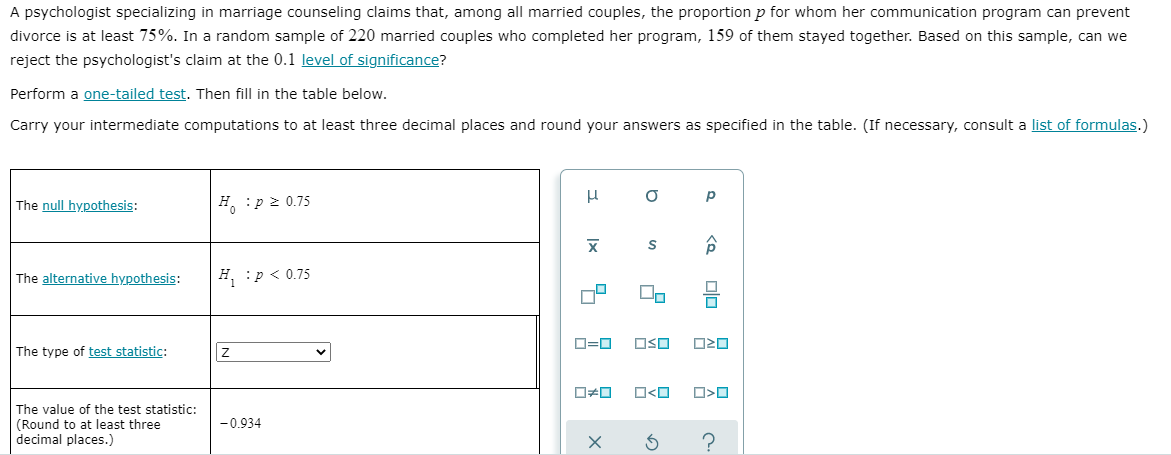A psychologist specializing in marriage counseling claims that, among all married couples, the proportion p for whom her communication program can prevent divorce is at least 75%. In a random sample of 220 married couples who completed her program, 159 of them stayed together. Based on this sample, can we reject the psychologist's claim at the 0.1 level of significance? Perform a one-tailed test. Then fill in the table below.
A psychologist specializing in marriage counseling claims that, among all married couples, the proportion p for whom her communication program can prevent divorce is at least 75%. In a random sample of 220 married couples who completed her program, 159 of them stayed together. Based on this sample, can we reject the psychologist's claim at the 0.1 level of significance? Perform a one-tailed test. Then fill in the table below.
Holt Mcdougal Larson Pre-algebra: Student Edition 2012
1st Edition
ISBN:9780547587776
Author:HOLT MCDOUGAL
Publisher:HOLT MCDOUGAL
Chapter11: Data Analysis And Probability
Section: Chapter Questions
Problem 8CR
Related questions
Topic Video
Question
A psychologist specializing in marriage counseling claims that, among all married couples, the proportion p for whom her communication program can prevent divorce is at least 75%. In a random sample of 220 married couples who completed her program, 159 of them stayed together. Based on this sample, can we reject the psychologist's claim at the 0.1 level of significance?
Perform a one-tailed test. Then fill in the table below.
Carry your intermediate computations to at least three decimal places and round your answers as specified in the table.

Transcribed Image Text:A psychologist specializing in marriage counseling claims that, among all married couples, the proportion p for whom her communication program can prevent
divorce is at least 75%. In a random sample of 220 married couples who completed her program, 159 of them stayed together. Based on this sample, can we
reject the psychologist's claim at the 0.1 level of significance?
Perform a one-tailed test. Then fill in the table below.
Carry your intermediate computations to at least three decimal places and round your answers as specified in the table. (If necessary, consult a list of formulas.)
The null hypothesis:
H. :p 2 0.75
The alternative hypothesis:
H :p < 0.75
D=D
OSO
O20
The type of test statistic:
O<O
The value of the test statistic:
(Round to at least three
decimal places.)
-0.934
?

Transcribed Image Text:The p-value:
(Round to at least three
decimal places.)
Can we reject the psychologist's claim that the
proportion of married couples for whom her
Yes
No
program can prevent divorce is at least 75%?
Expert Solution
This question has been solved!
Explore an expertly crafted, step-by-step solution for a thorough understanding of key concepts.
This is a popular solution!
Trending now
This is a popular solution!
Step by step
Solved in 2 steps

Knowledge Booster
Learn more about
Need a deep-dive on the concept behind this application? Look no further. Learn more about this topic, statistics and related others by exploring similar questions and additional content below.Recommended textbooks for you

Holt Mcdougal Larson Pre-algebra: Student Edition…
Algebra
ISBN:
9780547587776
Author:
HOLT MCDOUGAL
Publisher:
HOLT MCDOUGAL

College Algebra
Algebra
ISBN:
9781305115545
Author:
James Stewart, Lothar Redlin, Saleem Watson
Publisher:
Cengage Learning


Holt Mcdougal Larson Pre-algebra: Student Edition…
Algebra
ISBN:
9780547587776
Author:
HOLT MCDOUGAL
Publisher:
HOLT MCDOUGAL

College Algebra
Algebra
ISBN:
9781305115545
Author:
James Stewart, Lothar Redlin, Saleem Watson
Publisher:
Cengage Learning
